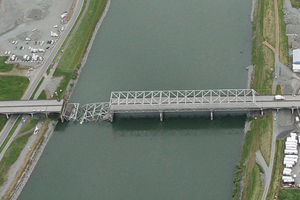Senior Reporter
Court Battles Still Being Fought Over Skagit River Bridge Mishap

There are depositions scheduled for April and May, court briefs yet to be filed, a possible mediation hearing in June and, if all settlement efforts fail, a trial that could drag into summer — or longer.
In its final 2014 report of the May 2013 mishap, the National Transportation Safety Board blamed Canadian motor carrier Mullen Trucking’s driver and crew, especially the driver of a pilot escort car for being on the phone with her husband just before the accident,. NTSB also noted that a weak permitting process by Washington transportation officials also contributed to the accident.
The NTSB investigation results largely were lmirrored in a civil lawsuit filed early last year against Mullen by the Washington State Department of Transportation, which claimed the company driver and pilot escort’s actions were “dangerous” and “negligent.”
The state’s lawsuit was consolidated in December with two separate lawsuits seeking undisclosed damages filed by three motorists who “suffered physical and emotional injuries” when their vehicles “plunged into the river” during the bridge collapse, according to court documents.
In addition to Mullen, defendants in the consolidated lawsuits include William Scott, the truck driver whose truck hit the bridge; the pilot escort vehicle driver, Tammy Detray; G&T Crawler Service; and Saxon Energy Services, whose metal casing shed was on the truck headed for Vancouver, Washington.
Scott stayed in the right southbound lane of the bridge, the state’s complaint said.
“Had Scott acted reasonably, prudently and safely by driving in the left southbound lane of the Skagit River Bridge, which had adequate vertical clearance, the Saxon load, the subject collision would not have occurred,” according to the WSDOT complaint.
The state did not comment on the case, instead relying on court documents to make its arguments.
But Mullen’s cross claim denies many of the state’s allegations and says that assessing legal blame in the case will be complex.
The legal discovery in the case is “just now unfolding,” said Mullen’s attorney, Thomas Tobin, a White Plains, New York-based partner of the national law firm of Wilson Elser.
“It’s like a lot of these accidents where there’s a conglomeration of factors, any one of which potentially might have avoided the calamity,” Tobin told Transport Topics.
“Our driver hit the bridge,” he added. “There’s very little doubt about that at this point. But there’s some fault to share here. It’s not quite so simple as a truck hitting a bridge. There were other things going on.”
Tobin said Mullen’s driver involved in the incident had almost 1million accident-free miles hauling oversize loads.
“Unfortunately, the bridge, which had been erected in 1954, was ‘fracture critical’ — meaning that the failure of any one of 88 critical elements would cause it to collapse,” Tobin added. “It had also been classified by the Federal Highway Administration as ‘functionally obsolete’ due to its narrow shoulders, narrow lanes and low vertical clearance.”
But Christopher Davis, a Seattle attorney representing two of the injured motorists, said that it is clear that the truck driver and pilot escort driver had “serious lapses of judgment and knowingly went over a bridge when they knew or should have known that their oversized load was going to strike a portion of the bridge.”
Davis said Mullen’s attorneys are attempting to blame three other parties, including the state of Washington. “It’s a fairly big case, complicated and has lots of parties,” he added. “But because the defendants have requested mediation, we’re feeling like they want to settle.”

